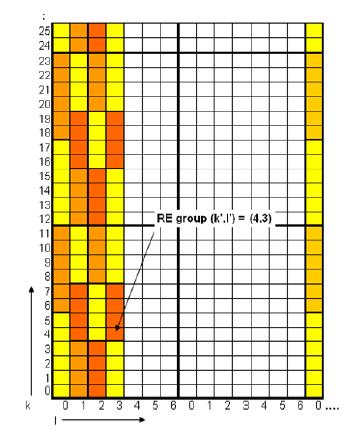RE – groups & CFI – Control Format Indication in LTE
RE – groups & CFI – Control Format Indication in LTE is as below.
RE – groups
In order to support DL control information mapping, RE-groups are defined.
Four useful symbols are bundled, useful in the sense that RE’s carrying the cellspecific reference symbols are not available.
The one cell-specific RS case is mapped in the same way as in the two cell-specific RS case .So the example sketched in the figure below applies for the one and two antenna cases. In the first symbol are six REs grouped, however only four are available as two are blocked by reference signals.
RE groups are aligned within one symbol and occupy consecutive frequencies (subcarriers). The RE groups are addressed by the index pair (k’,l’) where k’ is the lowest number among the REs of the considered group.

CFI – Control Format Indication
How many OFDM symbols per subframe are used for PDCCH is indicated on the PCFICH.
For non-MBSFN subframes and frame structure type 1 there are 1, 2 or 3 OFDM symbols used for PDCCH if more than 10 RB’s are configured in a cell, 2, 3 or 4 otherwise.
In order to signal the actual number 32 bits are in use. These bits are scrambled depending on the cell id and are modulated using QPSK.
Mapping and precoding is possible for
– single antenna port
– transmit diversity
The same antenna ports as for PBCH are used and 4 symbol quadruplets are mapped to resource elements.
RE – Groups & CFI – Control Format Indication in LTE
In LTE, RE (Resource Element) groups are used for the allocation of resources in the physical layer, organizing the transmission of reference signals, control information, and data. CFI (Control Format Indicator) is used to indicate the number of OFDM symbols used for control information in a subframe. The CFI helps the receiver to identify the position of control information, allowing proper decoding and efficient use of the available bandwidth for both control and data channels.